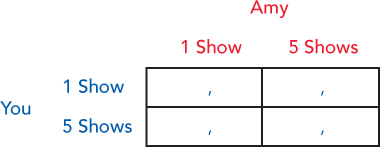CHAPTER 15 APPENDIX QUESTIONS
Question 15.16
1. Cat and mouse is a simple game in which each player can choose either Right or Left. If the cat and mouse both choose Right or both choose Left, however, that is very bad for the mouse but good for the cat. If the cat and mouse choose different strategies that is good for the mouse but not good for the cat.
Can you find a Nash equilibrium in this game?
Question 15.17
2. Suppose you and your friend Amy work together to develop a unique magic trick that either of you could perform alone. It turns out to be a tremendously popular trick and both of you make it big as professional magicians. Suppose you decide to conspire together and limit the number of performances featuring the trick. If both of you do only one show a week, each of you earns a profit of $10,000 for that show. If both of you do five shows a week, each of you earns a total profit of $6,000. If one does a single show while the other does five shows, the former gets a profit of $1,000 and the latter gets a profit of $15,000.
Use this information to complete the table. (Hint: It’ll look a lot like Figure 15.4.)

Suppose Amy does one show. What is your preferred strategy?
Suppose Amy does five shows. What is your preferred strategy?
What is your dominant strategy?
Suppose you do one show. What is Amy’s preferred strategy?
Suppose you do five shows. What is Amy’s preferred strategy?
What is Amy’s dominant strategy?
What is the Nash equilibrium?
Magicians are famously hesitant to reveal the secrets behind their magic, even to other magicians. Based on what you’ve learned in this question, why do they act like this? Is letting other magicians in on your secrets an optimal strategy?
Question 15.18
3. Imagine that two players are competing over a valuable resource. Each player has two options. He or she can either be aggressive and demand the entire resource, or the player can offer to split the resource equally. The literature uses the word “Hawk” to describe the aggressive behavior and the word “Dove” to describe the sharing behavior. If two Hawks meet, then both will demand the resource, neither will give in, and there will be a fight. If a Hawk meets a Dove, the Hawk will take the resource and the Dove will get nothing. If two Doves meet, the resource will be shared equally.
Assume that the value of the resource is 60, the cost of losing a fight is 100, and if two Hawks fight, each of them has a 50% chance of losing.
Here’s the payoff matrix:

Oops! The payoffs are missing. You’ll have to fill them in. Remember, if there’s a fight, there is a 50% chance of winning 60 but also a 50% of losing the fight, which has a payoff –100. What’s the expected outcome? If both animals choose Dove, assume that they peacefully split the resource. If one is a Hawk and the other is the Dove, the Hawk gets the resource, and the Dove receives nothing …
Explain why {Hawk-Dove} and {Dove-Hawk} are both Nash equilibriums.
The Hawk-Dove game is often used to discuss international relations. Can you explain why a country might like to be perceived as a Hawk? What are the dangers of being a Hawk? What are the dangers of being a Dove?
Biologists also use game theory to understand animal behavior, but they interpret the strategies a little differently. Instead of allowing an animal to choose a strategy, they assume that x percent of animals in a population will always play Hawk and 100 – x percent of animals in a population will always play Dove, and they also assume that animals will meet randomly.
306
Biologists argue that if Hawk has an expected higher payoff than Dove, then Hawks will outcompete Doves so that over time, evolution will increase the percentage of animals playing Hawk. Similarly, if Dove has a higher payoff, then over time, evolution will increase the percentage of animals playing Dove.
Can you find a strategy that is evolutionarily stable; that is, can you find a strategy where the percentages of animals playing Hawk and Dove are stable over time?
Here are two hints: Let x be the percentage of animals playing Hawk. If 0% percent of animals play Hawk (x = 0%) and thus all play Dove, is that evolutionarily stable? If all animals play Hawk (x = 100%), is that evolutionarily stable?
*OPEC had been around since 1960, but until the early 1970s, it didn’t have much success in raising the price of oil. OPEC became more powerful through the 1960s and 1970s as the participating countries nationalized oil fields and as more countries joined OPEC. In 1973, OPEC expanded from Iran, Iraq, Kuwait, and Saudi Arabia to add Qatar, Indonesia, Libya, the United Arab Emirates, Algeria, Nigeria, Ecuador, and Gabon. Ecuador left in 1992 but returned in 2007. Gabon left OPEC in 1995, Angola joined in 2007, and Indonesia left in 2009.